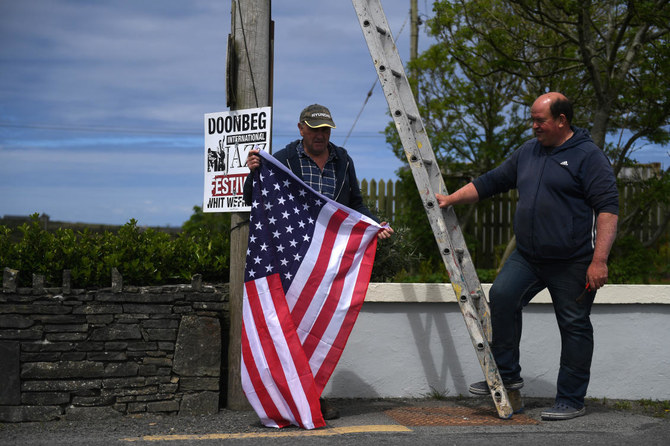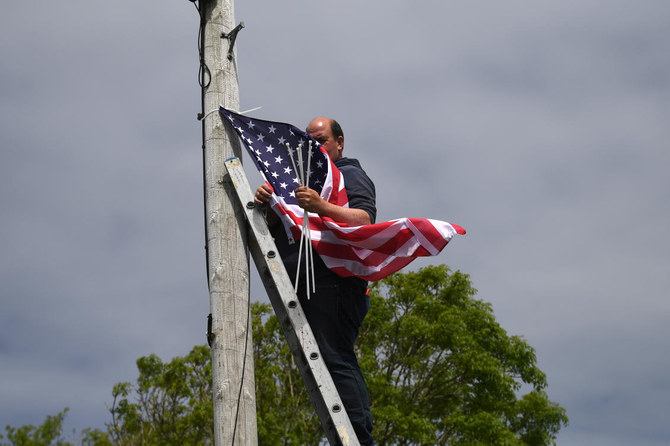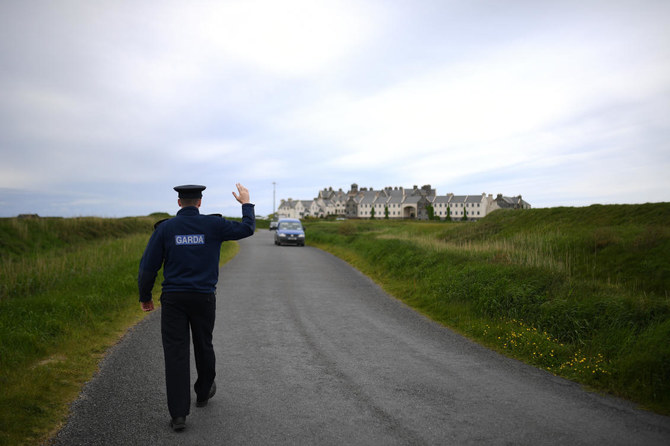DOONBEG, Ireland: In a small corner of Ireland’s west coast Donald Trump means jobs. And the locals are getting ready to line the street with the Stars and Stripes to express their gratitude when he visits next week.
Like in Britain, where Trump has been promised demonstrations on his first European stop, a number of Irish groups have called on people to protest against the president’s policies on issues such as immigration and climate change.
But in Doonbeg, where residents credit Trump with securing their livelihoods when he bought the nearby golf resort five years ago, the tiny village is being decked out in American flags and bunting in advance of his visit.
“There are over 300 employed here because of him, what else is around here?” Joe Pender said, as he and fellow locals Tommy Haugh and Danny Buckley were hanging flags from every lamppost in the one-street village.
“If we didn’t have the hotel, we’d have nothing here. It’d be a ghost town.”
Trump is expected to stay in his hotel for at least one night on June 5 in between visits to Britain and France, with security already stepped up in the area.
Pender, 60, remembers feeding cattle in the green fields where the Greg Norman-designed golf course was built in 2002 during Ireland’s “Celtic Tiger” boom years, promising to transform the local area.
He worked for the previous owners who placed the resort into receivership when Ireland’s boom turned to a spectacular bust a decade ago and unemployment in the region rocketed above 16 percent.
Trump, like many foreign investors, saw a potential bargain in Ireland and reaped the benefits as the economy grew faster than any other in Europe for five straight years, unemployment fell back below 5 percent and record numbers of tourists flocked to spots like Doonbeg, which overlooks the Atlantic Ocean.
“Nobody is perfect but if any place had what we had, they’d be on top of the world. He’s put bread and butter on the table,” said local priest Father Joe Haugh who, at the age of 87, still enjoys a round of golf — free of charge.
It is a top class course, according to Haugh, who is also flying an American flag outside his church for the visit.
But while Barack Obama was met by cheering crowds and struck public relations gold by sharing a Guinness with a distant cousin during the last presidential visit to Ireland in 2011, Trump should not expect a similar reception outside Doonbeg.
Irish Prime Minister Leo Varadkar opposed extending an invitation to Trump as a cabinet minister before changing his mind. He will meet the president at Shannon Airport, where a previous ministerial colleague was criticized by opposition politicians for greeting Trump on a red carpet on his last visit, as an investor, in 2014, before he was elected president.
Trump’s fans in Doonbeg are aware that he is a divisive figure, but it is still very difficult to find any among its population of 200 who will say a bad word against him.
“He has his own past but we didn’t elect the man. If our president went abroad and wasn’t welcomed, we’d be very upset. It’s courtesy,” said Ita Comerford, whose family have lived in the village for four generations.
Michael and Theresa McDermott, whose idyllic house overlooks the golf course, are in the security “red zone” and while they have identity passes to come and go next week, the one thing they cannot find is a US flag. The local shop is sold out.
With a night of Irish dancing and entertainment planned in the village while Trump is in town, local restaurant owner and publican Tommy Tubridy has been perfecting his Guinness pours, using careful tap skills to create the letters “T-R-U-M-P” in the creamy foam of the pint, just in case they get a visit.
“He’s a man that pulls a lot of surprises so you’d never know, he could pop down,” said Tubridy, who credits the hotel with keeping Doonbeg’s five pubs in business and even bringing home some of its emigrants hopeful of getting work again.
“He’s a non drinker though so he’d probably have a glass of the local spring water and that’d be grand.”
Tiny Irish village to welcome Trump with pride, not protest
Tiny Irish village to welcome Trump with pride, not protest

- In Doonbeg, where residents credit Trump with securing their livelihoods when he bought the nearby golf resort five years ago, the tiny village is being decked out in American flags
- Trump is expected to stay in his hotel for at least one night on June 5 in between visits to Britain and France, with security already stepped up in the area
Colombian authorities arrest alleged leader of Italian mafia in Latin America

- Italian Giuseppe Palermo, also known as ‘Peppe,’ was wanted under an Interpol red notice, which called for his arrest in 196 countries
- He was apprehended on the street in Colombia’s capital Bogota during a coordinated operation
Police identified the suspect as Giuseppe Palermo, also known as “Peppe,” an Italian who was wanted under an Interpol red notice, which called for his arrest in 196 countries.
He was apprehended on the street in Colombia’s capital Bogota during a coordinated operation between Colombian, Italian and British authorities, as well as Europol, the European Union’s law enforcement agency, according to an official report.
Palermo is believed to be part of “one of the most tightly knit cells” of the ‘ndrangheta mafia, said Carlos Fernando Triana, head of the Colombian police, in a message posted on X.
The ‘ndrangheta, one of Italy’s most powerful and secretive criminal organizations, has extended its influence abroad and is widely accused of importing cocaine into Europe.
The suspect “not only led the purchase of large shipments of cocaine in Colombia, Peru, and Ecuador, but also controlled the maritime and land routes used to transport the drugs to European markets,” Triana added.
Illegal cocaine production reached 3,708 tons in 2023, an increase of nearly 34 percent from the previous year, driven mainly by the expansion of coca leaf cultivation in Colombia, according to the United Nations.
US appeals court scraps 9/11 mastermind’s plea deal

- Khalid Sheikh Mohammed was regarded as one of bin Laden’s most trusted lieutenants
- He had spent three years in secret CIA prisons before arriving at Guantanamo in 2006
WASHINGTON: A US appeals court on Friday scrapped 9/11 mastermind Khalid Sheikh Mohammed’s plea agreement that would have taken the death penalty off the table and helped conclude the long-running legal saga surrounding his case.
The agreement had sparked anger among some relatives of victims of the 2001 attacks, and then-US defense secretary Lloyd Austin moved to cancel it last year, saying that both they and the American public deserved to see the defendants stand trial.
Austin “acted within the bounds of his legal authority, and we decline to second-guess his judgment,” judges Patricia Millett and Neomi Rao wrote.
Plea deals with Mohammed as well as two alleged accomplices — Walid bin Attash and Mustafa Al-Hawsawi — were announced in late July last year.
The decision appeared to have moved their cases toward resolution after years of being bogged down in pre-trial maneuverings while the defendants remained held at the Guantanamo Bay military base in Cuba.
But Austin withdrew the agreements two days after they were announced, saying the decision should be up to him, given its significance.
He subsequently said that “the families of the victims, our service members and the American public deserve the opportunity to see military commission trials carried out in this case.”
A military judge ruled in November that the deals were valid and binding, but the government appealed that decision.
The appeals court judges on Friday vacated “the military judge’s order of November 6, 2024, preventing the secretary of defense’s withdrawal from the pretrial agreements.”
And they prohibited the military judge “from conducting hearings in which respondents would enter guilty pleas or take any other action pursuant to the withdrawn pretrial agreements.”
Much of the legal jousting surrounding the 9/11 defendants’ cases has focused on whether they could be tried fairly after having undergone torture at the hands of the CIA — a thorny issue that the plea agreements would have avoided.
Mohammed was regarded as one of Al-Qaeda chief Osama bin Laden’s most trusted lieutenants before his March 2003 capture in Pakistan. He then spent three years in secret CIA prisons before arriving at Guantanamo in 2006.
The trained engineer — who has said he masterminded the 9/11 attacks “from A to Z” — was involved in a string of major plots against the United States, where he attended university.
The United States used Guantanamo, an isolated naval base, to hold militants captured during the “War on Terror” that followed the September 11 attacks in a bid to keep the defendants from claiming rights under US law.
The facility held roughly 800 prisoners at its peak, but they have since slowly been sent to other countries. A small fraction of that number remains.
Fuel to Air India plane was cut off moments before crash, investigation report says

- Report also indicated that both pilots were confused over the change to the switch setting, which caused a loss of engine thrust shortly after takeoff
- The Air India flight crashed on June 12 and killed at least 260 people, including 19 on the ground, in the northwestern city of Ahmedabad
NEW DELHI: Fuel control switches for the engines of an Air India flight that crashed last month were moved from the “run” to the “cutoff” position moments before impact, starving both engines of fuel, a preliminary investigation report said early Saturday.
The report, issued by India’s Aircraft Accident Investigation Bureau, also indicated that both pilots were confused over the change to the switch setting, which caused a loss of engine thrust shortly after takeoff.
The Air India flight – a Boeing 787-8 Dreamliner – crashed on June 12 and killed at least 260 people, including 19 on the ground, in the northwestern city of Ahmedabad. Only one passenger survived the crash, which is one of India’s worst aviation disasters.
The plane was carrying 230 passengers – 169 Indians, 53 British, seven Portuguese and a Canadian – along with 12 crew members.
According to the report, the flight lasted around 30 seconds between takeoff and crash. It said that once the aircraft achieved its top recorded speed, “the Engine 1 and Engine 2 fuel cutoff switches transitioned from RUN to CUTOFF position one after another” within a second. The report did not say how the switches could have flipped to the cutoff position during the flight.
The movement of the fuel control switches allow and cut fuel flow to the plane’s engines.
The switches were flipped back into the run position, the report said, but the plane could not gain power quickly enough to stop its descent after the aircraft had begun to lose altitude.
“One of the pilots transmitted “‘MAYDAY MAYDAY MAYDAY’,” the report said.
It also indicated confusion in the cockpit moments before the crash.
In the flight’s final moment, one pilot was heard on the cockpit voice recorder asking the other why he cut off the fuel. “The other pilot responded that he did not do so,” the report said.
The plane’s black boxes – combined cockpit voice recorders and flight data recorders – were recovered in the days following the crash and later downloaded in India.
Indian authorities had also ordered deeper checks of Air India’s entire fleet of Boeing 787 Dreamliner to prevent future incidents. Air India has 33 Dreamliners in its fleet.
Memorial in flood-ravaged Texas city becomes focal point of community’s grief

- Brooklyn Thomas, a Kerrville native, stopped by the memorial to affix flowers near a photograph of a high school friend who died in the flood
- On Friday night, a week after the flood hit, a vigil was held to honor those that died
KERRVILLE: A chain-link fence that separates Water Street in the center of Kerrville from the Guadalupe River just a few hundred feet away has become a makeshift memorial, with the flower-covered stretch serving as a focal point for a grieving community.
As survivors in hard-hit Kerr County begin to bury their dead, the memorial has grown, covered with laminated photographs of victims of last-week’s deadly flood that roared through camps and homes, killing at least 120 people.
“I just feel like this is a beautiful remembrance of the individuals that were lost here,” said Brooklyn Thomas, 27, who graduated from high school in Kerrville with Julian Ryan, a resident of nearby Ingram who died in the flood trying to save his family. “I think it’s something really cool for the community to come to see, to remember their loved ones, to share memories if they want to.”
Thomas and her family affixed flowers to the wall near a picture of Ryan. The smell of fresh-cut flowers hung in the air as people placed candles and other mementos along the sidewalk next to the fence. Signs hanging from the fence read “Hill Country Strong” and featured an outline of Texas filled with rolling green hills. A large Texas flag stood on one end of the memorial, flapping in the breeze.
Debi Leos, who grew up in the Hill Country town of Junction, said she stopped by the memorial to leave flowers in honor of Richard “Dick” Eastland, the beloved director of Camp Mystic who died trying to save some of the young girls at his camp.
“Hill Country is near and dear to me, and we came down here to pay our respects,” Leos said. “As a parent, I can only imagine what the families are going through.”
Friday evening, about 300 people showed up at the memorial for a vigil with speakers that included faith leaders and some who told harrowing tales of narrowly escaping the flood.
Michelle McGuire said she woke up July 4 at her apartment in Hunt, Texas, to find her bed and nightstand floating and quickly found herself in deep flood waters, clinging to a tree for life.
“Thank God I’m a good swimmer,” she said. “I didn’t want my mom to have to bury me.”
Marc Steele, bishop-elect of the Anglican Diocese of the Living Word, said the memorial has become a place where people of all different faiths and backgrounds can come together and share their grief.
“We like to take opportunities like this to come together and pray to God,” Steele said, “and also Sunday mornings we come together and worship in prayer for our sorrow and thanksgiving for lives that were saved.”
German backpacker found alive after 12 days missing in Australian outback

- Carolina Wilga vanished on June 29 from near the outback town of Beacon, about 254 kilometers north of Western Australia state capital Perth
- The backpacker was ‘ravaged by mosquitoes’ during her time stranded in the hostile terrain and was found exhausted
SYDNEY: Australian authorities said they found a 26-year-old German backpacker “safe and well” after she had been missing in a remote part of the country’s northwest for almost two weeks.
Carolina Wilga, who vanished on June 29 from near the outback town of Beacon, about 254 kilometers north of Western Australia state capital Perth, was found by a passing motorist on a road in the region on Friday, police said.
“This is a huge relief for her family and all of her loved ones,” Detective Jessica Securo said on Saturday in a media conference televised from Perth.
“To find Carolina safe and well is a fantastic result.”
Wilga was airlifted to a Perth hospital, where she was stable on Saturday, authorities said.
The backpacker was “ravaged by mosquitoes” during her time stranded in the hostile terrain and was found exhausted, dehydrated and with cuts and bruises, police said.
A large-scale search was initiated for Wilga after her vehicle was found abandoned in the state’s sparsely populated Wheatbelt region, which spans 154,862 square km.
Wilga planned to continue her travels in Australia once recovered, authorities said.
























